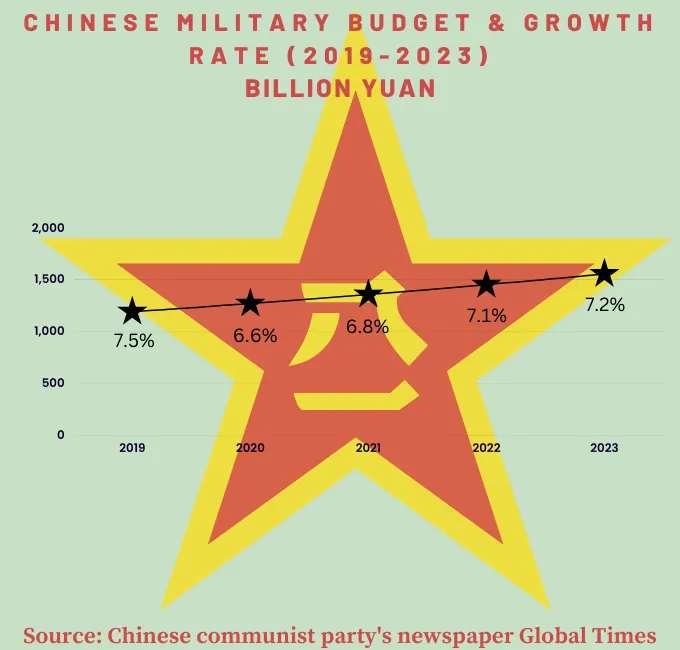China’s military budget has become a topic of great interest and speculation in recent years. As the second strongest economy in the world, China has consistently increased its defense spending over the past two decades, making it a significant player in global defense expenditures. This article aims to delve into the trends in Chinese military budget allocation, uncovering its patterns, estimating its actual magnitude, and exploring the implications of China’s defense spending for regional and global security.
Understanding China’s Announced Defense Budget Figures
In March 2023, China officially disclosed its defense budget for the year, amounting to $224.79 billion ( 1.5537 trillion renminbi ). This represented a 7.2% increase compared to the previous year’s budget. For the 8th consecutive year, the country’s defense budget has continued to experience a single-digit increase rate since 2016.
However, accurately calculating and assessing China’s actual defense spending is a complex task. The announced budget figures lack detail, and may not include several defense-related expenditures, such as paramilitary spending, personnel compensation costs, and research and development expenses.
Estimates and Discrepancies in Defense Spending
Observers, including the U.S. Department of Defense (DOD), believe that China’s defense spending is higher than officially acknowledged. For instance, in 2019, China announced a defense budget of approximately $177.6 billion, while the DOD estimated that China’s military-related spending could have exceeded $200 billion. The Stockholm International Peace Research Institute went even further, estimating China’s nominal defense spending to be as high as $240 billion. These disparities highlight the challenge of accurately determining China’s actual defense expenditure.
The Link between Defense Spending and Economic Growth
China’s defense spending is closely tied to its overall economic growth. Chinese leaders aim to align increases in defense expenditure with the country’s economic performance. As a result, China’s defense spending has remained relatively consistent as a percentage of its gross domestic product (GDP) since the mid-1990s. Projections by the DOD suggest that China’s economic growth will enable the country to sustain its growing defense expenditures for at least another 5 to 10 years.
Factors Driving China’s Defense Budget Growth
China’s defense white paper released in 2019 sheds light on the factors driving the increases in its military budget. These factors include improving compensation and resources for military personnel, integrating modern equipment while phasing out older ones, reforming and reorganizing the People’s Liberation Army (PLA), enhancing training quality and sophistication, and supporting diverse military tasks such as U.N. peacekeeping operations and regional/global military activities. The white paper provided a detailed explanation of China’s defense spending trends and objectives, which had not been done since 2010.
According to The Global Times, the Chinese Communist Party’s flagship newspaper, significant developments are anticipated for the People’s Liberation Army (PLA) in 2023. The PLA is set to induct advanced warplanes like the J-20 stealth fighter jets and J-16 multirole fighter jets, while retiring older J-7 fighter jets. Additionally, the PLA will conduct sea trials for its third aircraft carrier, the CNS Fujian, equipped with electromagnetic catapults. Observers also predict an increase in realistic combat-oriented drills, involving substantial expenditure on live munitions and fuels.
Under the guidance of Chinese President Xi Jinping, the military has been tasked with strengthening its capabilities with the potential objective of seizing Taiwan by 2027, which aligns with the centenary of the People’s Liberation Army (PLA). President Xi envisions building a globally renowned fighting force by 2049, coinciding with the centenary of Communist rule in China, representing his long-term vision for China’s military prowess.
Implications and Impact of Chinese Military Budget
China’s rising defense spending has significant implications for regional and global security. The growth of China’s defense capabilities has shifted power dynamics, raising concerns among neighboring countries and triggering responses to maintain their own security interests. China’s increased military budget aligns with its strategic ambitions to enhance its regional influence and protect its interests on the global stage.
Summary of Trends in Chinese Military Budget Allocation
China now ranks 3rd in the list of the most powerful militaries in the world. Chinese military budget continues to grow steadily, bolstering its defense capabilities and reinforcing its position as a major player in global security affairs. While the officially reported defense budget is substantial, estimates suggest that China’s actual defense spending might be even higher. Understanding China’s defense spending patterns and their implications is crucial for assessing the evolving security landscape and formulating effective regional and global responses. As China’s military budget remains on an upward trajectory, continued scrutiny and analysis are necessary to comprehend its full scope and impact on the world stage.








